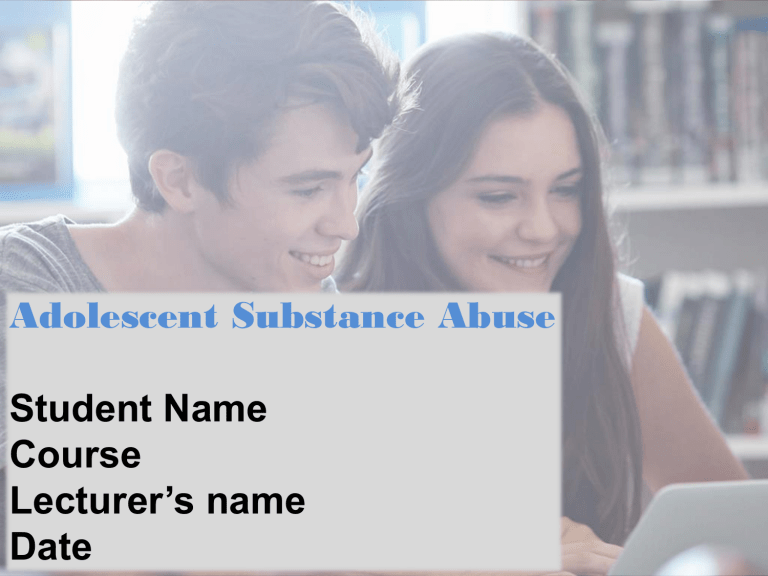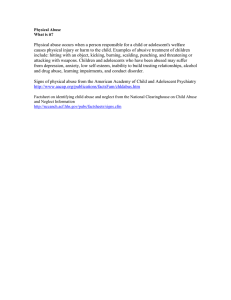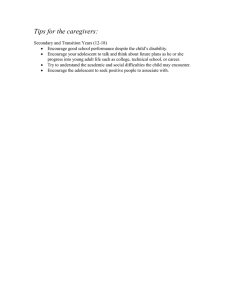
Adolescent Substance Abuse Student Name Course Lecturer’s name Date Prevalence of substance abuse among adolescents Prevalence of substance abuse among 12th graders 6,5 5 4 2 0 (CDC, 2020) Risk factors of substance abuse among adolescents Parental influences Family factors Community factors Individual factors Role of practitioner in helping substance use addiction Designing a public health approach Designs and implements strategies to combat risk factors Provide holistic management Screen and Identify addiction Provide management of withdrawal of acute intoxication (McNeely et al., 2018) Substance Abuse Treatment options by practitioners Treatment Options Detoxification Rehabilitation/Residential Ambulatory, intensive Ambulatory, non-intensive Ambulatory detoxification Effective management Adolescent-focused treatment Gender and cultural competence Progressive assessment and service Access to a continuum of care (McNeely et al., 2018) Warning signs Academic problems A new attitude Mood changes Mental and physical changes Discovery of drugs Change of friends (“Substance Misuse,”2022) Protective factors Individual factors School factors Community factors Protective Factors Family factors (Nawi et al., 2021) An Activity Lets take a quick Test 1. How many have used drugs before or know someone who did? 2. What was their motivation? 3. Have you ever witnessed any warning signs in a friend or classmate you assumed was using drugs? What did you do? 4. What would have you done? Help and support resources Federal resources Get Smart About Drugs The Substance Abuse and Mental Health Services Administration’s Treatment Facility Hotlines- Substance Abuse & Mental Health Services Administration National Helpline In states such as California Narcotic Treatment Programs (NTP) Driving Under the Influence (DUI) (“Substance Misuse,”2022) Preventive strategies to prevent adolescent substance abuse (parents) Establish clear guidelines and rules Know the adolescent's friends Understand the adolescent's activities Provide support, care, and trust Set a good example (Das et al., 2016) Consequences of adolescent substance abuse Broken relationships with friends and family Declining physical health Depression and anxiety Low self-esteem Poor judgment Poor performance in school Sexual promiscuity (Das et al., 2016) References “Substance Misuse” (2022). Youth.gov. https://youth.gov/youth-topics/substanceabuse CDC (2020). Teen Substance Use & Risks. https://www.cdc.gov/ncbddd/fasd/features/teen-substance-use.html Das, J. K., Salam, R. A., Arshad, A., Finkelstein, Y., & Bhutta, Z. A. (2016). Interventions for Adolescent Substance Abuse: An Overview of Systematic Reviews. The Journal of adolescent health : official publication of the Society for Adolescent Medicine, 59(4S), S61–S75. https://doi.org/10.1016/j.jadohealth.2016.06.021 McNeely, J., Kumar, P. C., Rieckmann, T., Sedlander, E., Farkas, S., Chollak, C., ... & Rotrosen, J. (2018). Barriers and facilitators affecting the implementation of substance use screening in primary care clinics: a qualitative study of patients, providers, and staff. Addiction science & clinical practice, 13(1), 1-15. https://doi.org/10.1186/s13722-018-0110-8 Nawi, A. M., Ismail, R., Ibrahim, F., Hassan, M. R., Manaf, M. R. A., Amit, N., ... & Shafurdin, N. S. (2021). Risk and protective factors of drug abuse among adolescents: a systematic review. BMC public health, 21(1), 1-15. https://doi.org/10.1186/s12889-021-11906-2




